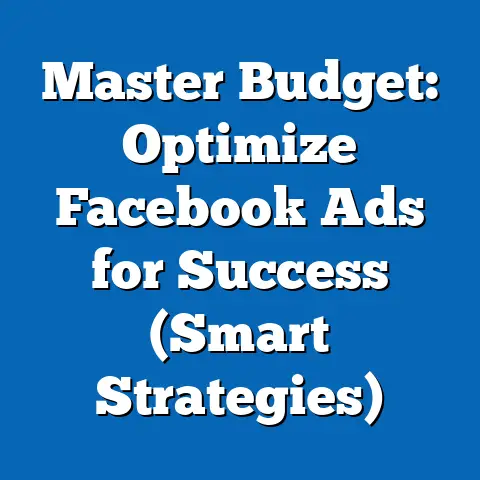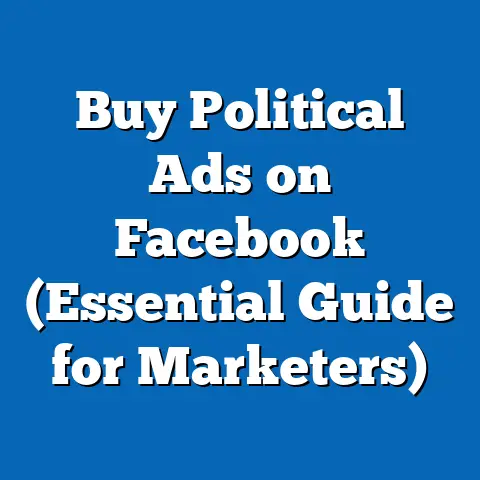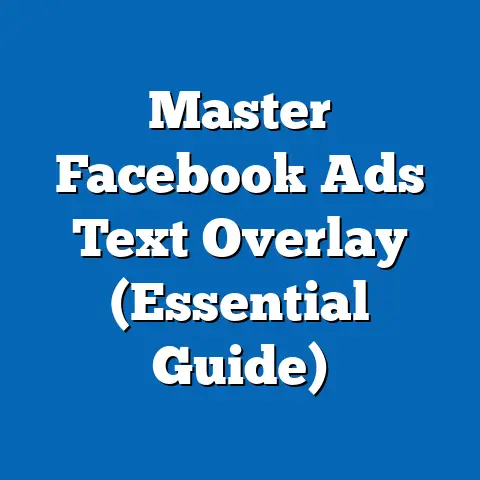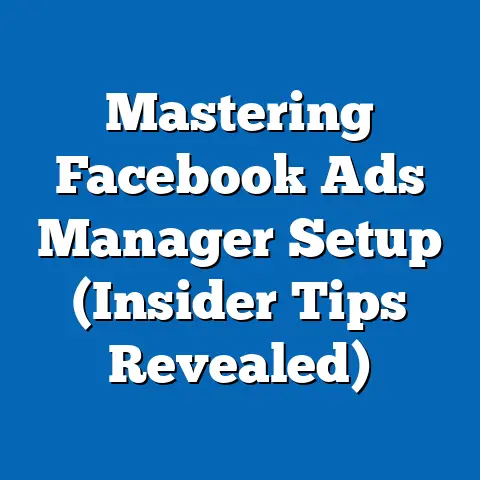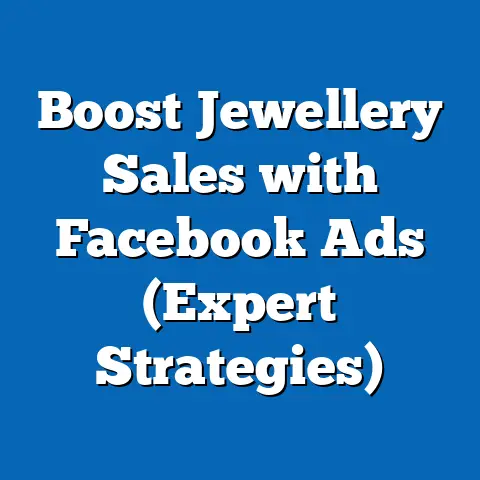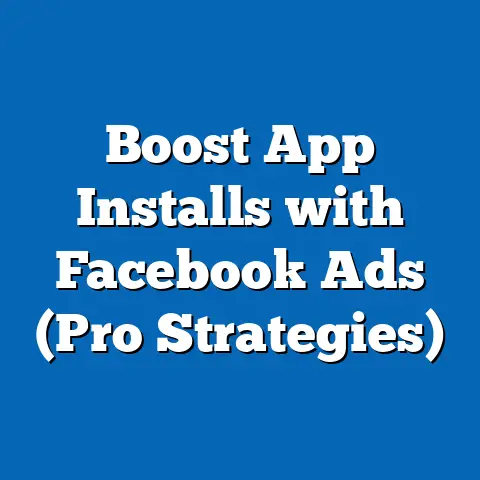Boost Ads with Facebook Templates (Proven Strategies)
Creating effective Facebook ads can sometimes feel like navigating a minefield. The pressure to craft visually appealing, engaging, and high-converting ads is immense, especially when you’re juggling numerous other marketing tasks. I remember one time when I was launching a new product. I spent weeks agonizing over every detail of the ad creative, only to see mediocre results. It was exhausting and frankly, disheartening. But what if I told you there’s a way to alleviate that stress and streamline your ad creation process? That’s where Facebook ad templates come in.
In today’s fast-paced digital landscape, leveraging pre-designed templates can be a game-changer. They provide a solid foundation, allowing you to focus on strategic messaging and audience targeting rather than getting bogged down in design minutiae. Using templates not only saves valuable time but also enhances creativity by offering a structured framework to build upon. This guide will explore how to leverage Facebook ad templates to create campaigns that are not only visually stunning but also highly effective in achieving your marketing goals. Let’s dive in and unlock the potential of templates to transform your Facebook advertising strategy.
Understanding Facebook Ads Templates
So, what exactly are Facebook ad templates, and how do they work? Simply put, they are pre-designed layouts and formats provided by Facebook that marketers can customize to create visually appealing and engaging ads. These templates are designed to streamline the ad creation process, offering a starting point that eliminates the need to build an ad from scratch.
There’s a template for almost every ad format you can think of. Here are a few common types:
- Carousel Ads: These templates are perfect for showcasing multiple products or features within a single ad. They allow users to swipe through a series of images or videos, each with its own headline, description, and call-to-action.
- Video Ads: Video templates are designed to optimize the viewing experience on Facebook. They often include elements like text overlays, animations, and sound effects to capture attention and convey your message effectively.
- Image Ads: These are the simplest and most versatile templates, ideal for highlighting a single product or message. They typically feature a high-quality image or graphic along with compelling copy and a clear call-to-action.
- Lead Generation Ads: These templates are designed to capture leads directly within Facebook. They include pre-built forms that users can fill out without leaving the platform, making it easy to collect valuable contact information.
What I love about Facebook ad templates is that they cater to a wide range of marketing goals. Whether you’re aiming to increase brand awareness, generate leads, drive website traffic, or boost sales, there’s a template designed to help you achieve your objectives. For instance, if your goal is to increase brand awareness, you might opt for a video ad template that allows you to tell your brand’s story in a visually compelling way. On the other hand, if you’re focused on lead generation, a lead ad template with a compelling offer and easy-to-fill form would be more effective.
One of the most underrated benefits of using templates is the ability to maintain brand consistency across different campaigns. By adhering to a consistent visual style and messaging framework, you can reinforce your brand identity and create a cohesive experience for your audience. This is particularly important for businesses with a strong brand presence and a desire to maintain a consistent image across all marketing channels.
Key Takeaway: Facebook ad templates are pre-designed layouts that streamline ad creation and cater to various marketing goals, helping maintain brand consistency.
The Advantages of Using Facebook Ad Templates
The advantages of using Facebook ad templates extend far beyond simple convenience. They offer a trifecta of benefits: efficiency, aesthetics, and effectiveness.
- Efficiency: Let’s face it, time is money. Templates significantly reduce the time and effort required to create high-quality ads. Instead of starting from scratch, you can simply choose a template that aligns with your campaign objectives and customize it to suit your brand. This allows you to deploy campaigns more quickly and focus on other critical marketing tasks.
- Aesthetics: Templates are professionally designed by experienced designers, ensuring that your ads are visually appealing and engaging. They incorporate best practices in visual hierarchy, typography, and color theory to capture attention and convey your message effectively. This is particularly important on a platform like Facebook, where users are constantly bombarded with visual stimuli.
- Effectiveness: Templates are designed to drive results. They incorporate elements that are proven to increase engagement, such as compelling headlines, persuasive copy, and clear calls-to-action. By leveraging these pre-built elements, you can increase the likelihood that your ads will resonate with your target audience and achieve your desired outcomes.
One of the most significant benefits of using templates is their ability to enhance visual appeal and engagement. I’ve seen firsthand how a well-designed template can transform a lackluster ad into a captivating masterpiece. The professionally designed layouts, carefully chosen color palettes, and strategic use of visual elements all contribute to creating an ad that stands out from the crowd and grabs the attention of potential customers.
Templates also make it easier to test and iterate quickly. Because the basic design is already in place, you can focus on experimenting with different headlines, copy variations, and calls-to-action to see what resonates best with your audience. This allows you to gather valuable performance insights and optimize your campaigns for maximum impact.
While it’s hard to put a definitive number on the effectiveness of template-driven ads versus custom designs, studies have shown that ads created with templates can achieve higher click-through rates and conversion rates compared to those built from scratch. This is likely due to the fact that templates incorporate best practices in design and messaging, as well as the ability to quickly test and iterate on different variations.
Key Takeaway: Facebook ad templates offer efficiency, enhance aesthetics, and increase effectiveness, leading to better campaign performance.
Proven Strategies to Maximize the Impact of Facebook Templates
While templates provide a solid foundation, maximizing their impact requires a strategic approach. Here are several proven strategies to help you get the most out of Facebook ad templates:
- Customization: The key to success with templates is customization. Don’t just use them as they are. Instead, take the time to personalize them with your brand colors, logos, and messaging to ensure they resonate with your target audience. This includes adjusting the fonts, images, and layout to match your brand’s visual identity.
- A/B Testing: Templates are perfect for A/B testing. Use different templates with slight variations in headlines, copy, or calls-to-action to identify which designs and formats yield the best results. This allows you to optimize your campaigns for maximum performance and continuously improve your results over time.
- Audience Targeting: Adapt templates for various audience segments to ensure relevance and increase engagement. Consider creating different versions of your ads that speak directly to the needs and interests of each audience segment. This might involve using different images, headlines, or copy that resonate with specific demographics, interests, or behaviors.
- Call-to-Action Optimization: The call-to-action (CTA) is one of the most critical elements of any ad. Strategically place CTAs within templates to drive user action. Experiment with different CTA buttons, such as “Shop Now,” “Learn More,” or “Sign Up,” to see which ones generate the most clicks and conversions.
I cannot stress enough the importance of customization. I’ve seen countless businesses make the mistake of using templates without adding their own personal touch, resulting in ads that look generic and fail to capture attention. Remember, your ads should reflect your brand’s unique personality and value proposition.
A/B testing is another powerful strategy for maximizing the impact of templates. By testing different variations of your ads, you can identify which elements are most effective in driving engagement and conversions. For example, you might test different headlines, images, or calls-to-action to see which ones resonate best with your target audience.
Audience targeting is also crucial. Creating ads that are highly relevant to your target audience is essential for driving engagement and conversions. This means tailoring your messaging, visuals, and offers to the specific needs and interests of each audience segment.
Finally, don’t underestimate the power of a well-placed call-to-action. Your CTA should be clear, concise, and compelling, telling users exactly what you want them to do. Experiment with different CTA buttons to see which ones generate the most clicks and conversions.
Key Takeaway: Maximize template impact through customization, A/B testing, audience targeting, and call-to-action optimization.
Real-World Examples of Successful Facebook Ad Template Usage
To illustrate the power of Facebook ad templates, let’s take a look at some real-world examples of brands that have successfully utilized them:
- Example 1: A Clothing Retailer Using Carousel Ads: A popular clothing retailer used a carousel ad template to showcase their new spring collection. Each image in the carousel featured a different outfit, complete with pricing and a “Shop Now” button. The campaign was highly successful, driving a significant increase in website traffic and online sales.
- Example 2: A Software Company Using Video Ads: A software company used a video ad template to demonstrate the key features of their product. The video featured a series of short, engaging clips that highlighted the benefits of the software. The campaign resulted in a surge of sign-ups for their free trial.
- Example 3: A Local Restaurant Using Image Ads: A local restaurant used an image ad template to promote their new lunch specials. The ad featured a mouthwatering photo of one of their signature dishes, along with a compelling headline and a “Learn More” button. The campaign drove a significant increase in lunchtime traffic to the restaurant.
In each of these examples, the brands chose templates that aligned with their campaign objectives and customized them to suit their brand. They also targeted their ads to specific audience segments, ensuring that their messaging resonated with potential customers.
What made these campaigns successful? In addition to template choice and customization, target audience alignment played a crucial role. By targeting their ads to specific demographics, interests, and behaviors, these brands were able to reach the right people with the right message at the right time.
The results achieved by these brands were impressive, including significant increases in engagement metrics, conversion rates, and overall return on investment. This demonstrates the power of Facebook ad templates when used strategically and effectively.
Key Takeaway: Successful template usage involves choosing the right template, customizing it effectively, aligning it with the target audience, and tracking results.
Future Trends in Facebook Advertising and Template Usage
As Facebook’s advertising landscape continues to evolve, several emerging trends are likely to influence the future use of templates:
- AI-Driven Design Tools: The rise of AI-driven design tools will make it easier than ever to create visually stunning and highly effective ads. These tools can automatically generate templates based on your brand guidelines, target audience, and campaign objectives, saving you even more time and effort.
- Increased Personalization: As consumers become more discerning, personalization will become even more critical for driving engagement and conversions. Templates will need to be highly customizable to allow marketers to tailor their ads to the specific needs and interests of individual users.
- Platform Updates: Facebook is constantly updating its advertising platform with new features and capabilities. Marketers will need to stay up-to-date on these changes and adapt their template strategies accordingly.
I believe that AI-driven design tools will be a game-changer for Facebook advertising. These tools can analyze vast amounts of data to identify the most effective design elements and generate templates that are optimized for performance.
Increased personalization will also be a key trend. Consumers are more likely to engage with ads that are tailored to their specific needs and interests. This means that marketers will need to use data and insights to create highly personalized templates that resonate with individual users.
Of course, staying up-to-date on platform updates is essential for any Facebook advertiser. Facebook is constantly evolving, and marketers need to be aware of the latest changes and adapt their strategies accordingly.
Key Takeaway: Future trends include AI-driven design, increased personalization, and adapting to platform updates.
Conclusion
In conclusion, Facebook ad templates offer a powerful and convenient way to create effective advertising campaigns. They provide a solid foundation, allowing you to focus on strategic messaging, audience targeting, and optimization. By leveraging the proven strategies discussed in this guide, you can maximize the impact of templates and achieve your marketing goals.
I’ve seen firsthand how templates can transform a struggling ad campaign into a resounding success. They offer a perfect blend of efficiency, aesthetics, and effectiveness, making them an invaluable tool for any marketer.
Remember, the key to success with templates is customization. Don’t just use them as they are. Instead, take the time to personalize them with your brand colors, logos, and messaging to ensure they resonate with your target audience.
So, are you ready to take your Facebook advertising to the next level? I encourage you to consider integrating templates into your advertising strategies to enhance efficiency, creativity, and ultimately drive better results.
Call to Action:
I’d love to hear about your experiences with Facebook ad templates. Share your thoughts and insights in the comments below, or reach out to me directly for more personalized advice on optimizing your ad strategies. Let’s work together to unlock the full potential of Facebook advertising and achieve your business goals!

